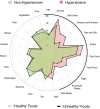Evaluating modifiable hypertension risk in Nigerian adults-The Nigerian diet risk score
- PMID: 39925098
- PMCID: PMC11965004
- DOI: 10.1111/tmi.14089
Evaluating modifiable hypertension risk in Nigerian adults-The Nigerian diet risk score
Abstract
Aims: Our study aimed to derive and validate a diet risk score for clinical use in Nigeria to screen for hypertension risk and evaluate its association against a panel of cardiovascular biomarkers.
Methods: The Nigerian dietary screening tool was used to collect dietary intake data from 151 participants visiting the River State University Teaching Hospital, Port Harcourt, Nigeria, for routine medical care. Blood samples were collected from a subsample (n = 94) for biomarker assessment. Multiple logistic regression was used to derive the Nigerian diet risk score for hypertension. Internal validation of the Nigerian diet risk score for hypertension was performed using measures of discrimination and calibration. Mediation analysis was used to evaluate the biomarker-mediated effects of the diet risk score for hypertension on hypertension. All statistical analyses were performed in R.
Results: Each one-point increment in Nigerian diet risk score (on a scale of 0 to 30) was associated with a twofold increase in odds of hypertension (odds ratio: 2.04, 95% confidence interval [CI]: 1.16, 3.58, p = 0.01), with the highest score associated with >18-fold increased odds of hypertension, compared to lowest Nigerian diet risk score for hypertension. The score demonstrated good discrimination (area under the curve: 0.92, 95% CI: 0.80, 1.00) with a high sensitivity (0.85) and specificity (0.94). Additionally, mediation analysis suggested that the association between Nigerian diet risk score for hypertension and blood pressure is partly explained by shared biological pathways that mediate cholesterol, triglycerides, LDL-C, CRP and homocysteine levels.
Conclusion: The resulting Nigerian diet risk score for hypertension is a valuable tool for clinicians to identify individuals at risk of hypertension, and will advance community efforts in the prevention and management of hypertension in Nigeria.
Keywords: biomarkers; clinical practice; diet risk score; hypertension; mediation analysis.
© 2025 The Authors Tropical Medicine & International Health published by John Wiley & Sons Ltd.
Conflict of interest statement
The authors have no conflicts of interest to disclose.
Figures






References
-
- Mozaffarian D, Fahimi S, Singh GM, Micha R, Khatibzadeh S, Engell RE, et al. Global sodium consumption and death from cardiovascular causes. N Engl J Med. 2014;371(7):624–634. - PubMed
-
- World Health Organization . Prevalence of hypertension among adults aged 30‐79 years, age‐standardized: Global Health Observatory. 2024. [cited 2025 Jul 1]. Available from: https://www.who.int/data/gho/data/indicators/indicator‐details/gho/preva...
-
- Parati G, Lackland DT, Campbell NRC, Owolabi MO, Bavuma C, Mamoun Beheiry H, et al. How to improve awareness, treatment, and control of hypertension in Africa, and how to reduce its consequences: A call to action from the world hypertension league. Hypertension. 2022;79(9):1949–1961. - PubMed
Publication types
MeSH terms
Substances
Grants and funding
LinkOut - more resources
Full Text Sources
Medical
Research Materials
Miscellaneous

